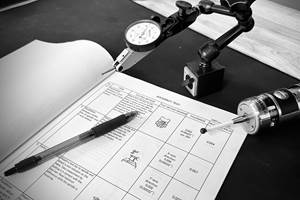You Won't Err With Air
It is perfectly natural that machinists should have an affinity for mechanical gages. To a machinist, the working of a mechanical gage is both straightforward and pleasing.
Share




Autodesk, Inc.
Featured Content
View More

Takumi USA
Featured Content
View More



.png;maxWidth=45)
DMG MORI - Cincinnati
Featured Content
View MoreIt is perfectly natural that machinists should have an affinity for mechanical gages. To a machinist, the working of a mechanical gage is both straightforward and pleasing. Air gages, on the other hand, rely on the action of a fluid material, the dynamics of which are hard to (shall we say?) grasp. But air gaging has many advantages over mechanical gages and should be seriously considered as an option for many applications.
Air gages are capable of measuring to tighter tolerances than mechanical gages. The decision break-point generally falls around 0.0005 inch; if your tolerances are tighter than that, air gaging provides the higher resolution you will need. At their very best, mechanical gages are capable of measuring down to 50 millionths, but that requires extreme care. Air gages handle 50 millionths with ease, and some will measure to a resolution of 5 millionths.
But let’s say your tolerances are around 0.0001 inch, and mechanical gaging would suffice. Air still provides advantages.
The high pressure jet of air automatically cleans the surface of the workpiece of most coolants, chips and grit, aiding in accuracy and saving the operator the trouble of cleaning the part. The air jet also provides self-cleaning action for the gage plug itself. However, the mechanical plug-type gages can become clogged with cutting oil or coolant and may require occasional disassembly for cleaning.
The contacts and the internal workings of mechanical plug gages are subject to wear. There’s nothing to wear on an air plug except the plug itself, and that has such a large surface area that wear occurs very, very slowly. Air gages consequently require less frequent mastering and, in abrasive applications, less frequent repair or replacement.
On some highly polished or lapped workpieces, mechanical gage contacts can leave visible marks. Air gaging, as a non-contact operation, won’t mark fine surfaces. For the same reason, air gaging can be more appropriate for use on workpieces that are thin-walled, made of soft materials or otherwise delicate. Continuous processes also benefit from non-contact gaging.
Air equipment can save time in almost any gaging task that is not entirely straightforward. Air plugs with separate circuits can take several measurements simultaneously on a single workpiece, for example, to measure diameters at the top and bottom of a bore for absolute dimensions or to check for taper. Jets can be placed very close together for measurements of closely spaced features.
Air plugs are available (or can be readily engineered as “specials”) to measure a wide range of shapes that would be difficult with mechanical tools.
It would be possible to design a fixture gage with a number of dial indicators to measure several dimensions in a single setup, such as diameters of all the bearing journals on a crankshaft. But a fixture gage using air gaging will almost inevitably be simpler in design and fabrication, easier to use, less expensive and more accurate.
Because of the relative simplicity of fixture design, air gaging is especially suited to relational as opposed to dimensional measurements, such as squareness (see illustration), taper, twist, parallelism and concentricity.
Air gaging isn’t perfect, though. Its high level of resolution makes air gaging impractical for use on workpieces with surface finish rougher than 50 microinches Ra because the readings would average the highs and lows of the rough surface. Most important, air gaging has relatively high initial cost, so it is usually reserved for large production runs. Clean, compressed air is also expensive to generate and must be figured into the equation.
Related Content
How to Evaluate Measurement Uncertainty
Manufacturing and measurement are closely coupled. An important consideration for the use of measurement results is the associated measurement uncertainty. This article describes common metrology terms and provides an example uncertainty analysis.
Read MoreThe Link Between CNC Process Control and Powertrain Warranties
Ever since inventing the touch-trigger probe in 1972, Sir David McMurtry and his company Renishaw have been focused on achieving process control over its own manufacturing operations. That journey has had sweeping consequences for manufacturing at large.
Read MoreHow to Choose the Correct Measuring Tool for Any Application
There are many options to choose from when deciding on a dimensional measurement tool. Consider these application-based factors when selecting a measurement solution.
Read More4 Ways to Establish Machine Accuracy
Understanding all the things that contribute to a machine’s full potential accuracy will inform what to prioritize when fine-tuning the machine.
Read MoreRead Next
Registration Now Open for the Precision Machining Technology Show (PMTS) 2025
The precision machining industry’s premier event returns to Cleveland, OH, April 1-3.
Read More5 Rules of Thumb for Buying CNC Machine Tools
Use these tips to carefully plan your machine tool purchases and to avoid regretting your decision later.
Read MoreSetting Up the Building Blocks for a Digital Factory
Woodward Inc. spent over a year developing an API to connect machines to its digital factory. Caron Engineering’s MiConnect has cut most of this process while also granting the shop greater access to machine information.
Read More
































.jpg;maxWidth=300;quality=90)










